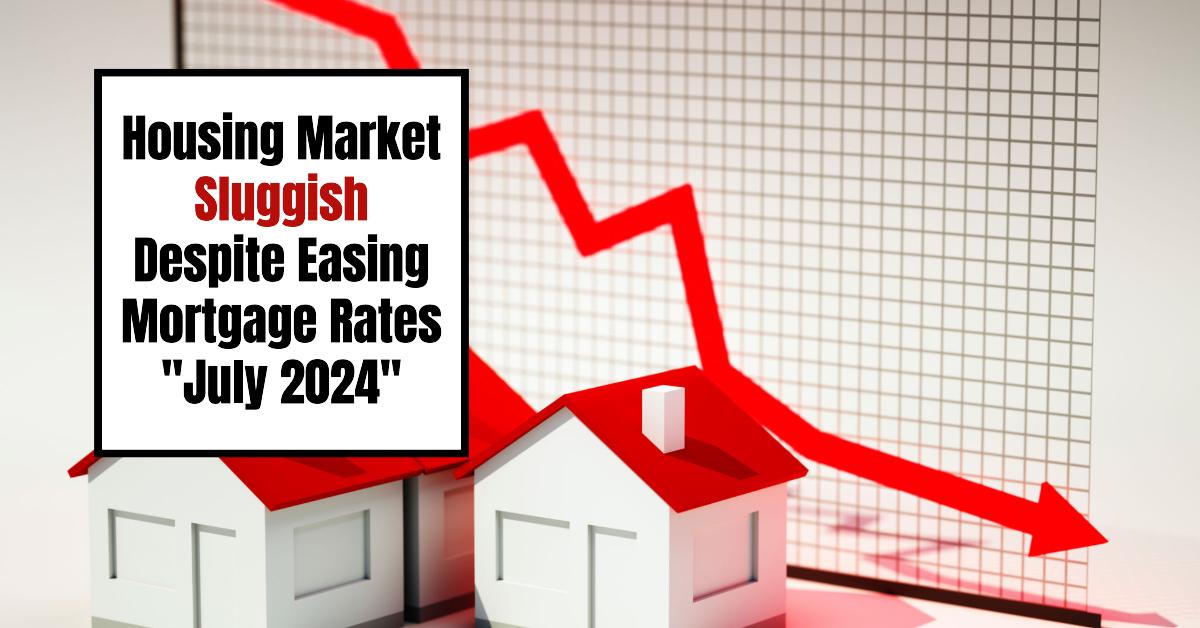The sentiment that “home sales are still sluggish” is resonating strongly in the housing market. This declaration by Lawrence Yun, the National Association of Realtors’ chief economist, highlights the ongoing challenges in the housing market, despite a recent uptick in sales figures. As potential homeowners and investors seek clarity and insights, understanding the factors contributing to this sluggishness is crucial.
Housing Market Sluggish Despite Easing Mortgage Rates
Key Takeaways
- Home sales rose 1.3% in July compared to June, totaling a seasonally adjusted annual rate of 3.95 million.
- Sales decreased by 2.5% compared to July 2023, indicating a year-over-year decline.
- The median home price hit $422,600, a 4.2% annual increase.
- About 1.33 million unsold homes were on the market in July, representing a 4-month supply.
- First-time buyers account for 29% of sales, down from historical averages of 40%.
The Current State of Home Sales
The July 2024 data from the National Association of Realtors (NAR) shows that existing home sales managed to pull away from a four-month downward trend, increasing by 1.3% from June. However, this modest gain belies a more significant issue: home sales are still down 2.5% compared to the previous year. This persistent sluggishness raises concerns among economists, especially when we consider the implications for home buyers and sellers.
Despite a slight rebound, home prices continue to escalate. The national median sale price for existing homes has reached $422,600, a notable 4.2% increase over last year. This marks the 13th consecutive month of price hikes, and while it’s down from the peak reached in June, it's the highest recorded for the month of July, indicating pressure on buyers in an already competitive environment.
Understanding the Root Causes
The sluggish sales can be attributed to several interwoven factors:
- High Mortgage Rates: Following the pandemic, mortgage rates skyrocketed, leading to a significant decline in home purchases. The average 30-year mortgage rate hit a 23-year high of 7.79%. While there has been some easing, bringing rates down to about 6.5% recently, many buyers still find homeownership out of reach due to the historical cost increase in homes.
- Supply and Demand Dynamics: At the end of July, there were about 1.33 million unsold homes, up nearly 20% from last year. This rise in inventory translates to a 4-month supply of homes for sale, an improvement from the previous year's 3.3-month supply. Traditionally, a balanced market is achieved with a 5 to 6-month supply, suggesting potential stabilization in the market.
- Extended Time on Market: Homes are taking longer to sell, averaging 24 days on the market in July compared to 22 days in June. This shift indicates that buyers are more cautious, potentially waiting for better affordability before making offers.
- Declining Investor Activity: The presence of cash buyers remains significant, accounting for 27% of transactions, but this is down slightly from last year. Moreover, the percentage of homes purchased by individual investors has also decreased, signaling a change in market dynamics.
Future Outlook
Will home sales improve in the coming months? Many economists are hopeful, suggesting that if mortgage rates continue on their downward trajectory, there could be an uptick in home sales. Lawrence Yun indicated that easing inflation expectations could prompt the Federal Reserve to cut interest rates, which would further impact mortgage affordability.
What Buyers Should Consider
As the market continues to evolve, potential homebuyers must consider their options carefully. Here are some tips:
- Stay Informed About Interest Rates: With predictions that mortgage rates may fall to 6.3% by the year's end, being aware of market trends can help buyers navigate the best time to secure a loan.
- Evaluate the Inventory: Increasing inventory offers more choices, but it’s essential to analyze what fits within your budget and long-term goals.
- Financial Preparedness: Ensuring you are financially ready, especially if you're a first-time buyer, can provide a competitive edge in the current market.
The assertion from Lawrence Yun that “home sales are still sluggish” captures the precarious position many find themselves in today’s real estate market. While there are signs of improvement, numerous challenges persist, making it essential for buyers and sellers alike to stay informed and adapt their strategies accordingly. As we move into the next season, the hope is that the housing market will continue to stabilize, allowing for more transactions and enhanced opportunities for all involved.
ALSO READ:
- Is the Housing Market on the Brink in 2024: Crash or Boom?
- Trump vs Harris: Which Candidate Holds the Key to the Housing Market (Prediction)
- 2008 Forecaster Warns: Housing Market 2024 Needs This to Survive
- Housing Market Predictions for the Next 2 Years
- Housing Market Predictions for Next 5 Years (2024-2028)
- Housing Market Predictions 2024: Will Real Estate Crash?
- Housing Market Predictions: 8 of Next 10 Years Poised for Gains





